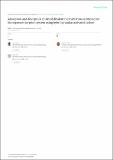| dc.contributor.author | Jonas, Bayuo | |
| dc.contributor.author | Rwiza, Mwemezi | |
| dc.contributor.author | Mtei, Kelvin | |
| dc.date.accessioned | 2023-10-11T07:38:19Z | |
| dc.date.available | 2023-10-11T07:38:19Z | |
| dc.date.issued | 2023-09 | |
| dc.identifier.uri | https://doi.org/10.1007/s10661-023-11540-y | |
| dc.identifier.uri | https://dspace.nm-aist.ac.tz/handle/20.500.12479/2238 | |
| dc.description | This research article was published in Environmental Monitoring and Assessment, Volume 195, 2023. | en_US |
| dc.description.abstract | The sequestration of heavy metals from multicomponent sorption media has become critical due to the noxious effects of heavy metals on the natural environment and subsequently on human health as well as all life forms. The abatement of heavy metals using bio-adsorbents is one of the efficient and affordable approaches for treating water and wastewater. Therefore, the interactive effect of arsenic [As(III)] ions on the sorption and desorption ability of mercury [Hg(II)] from a binary sorption system was conducted. More so, the impact of reaction time, solution pH, bio-adsorbent particle size, bio-adsorbent dose, initial mono-metal, and binary-metal concentration as well as reaction temperature on the individual and competitive sorption of Hg(II) was explored. The study showed that Hg(II) could be removed effectively from the single-component system and competitively from the aqueous phases by the bio-adsorbent in the coexistence of As(III) species in the bicomponent medium. The adsorptive detoxification of Hg(II) from the monocomponent and bicomponent sorption media showed dependence on all the studied adsorption parameters. The occurrence of As(III) species in the bicomponent sorption medium affected the decontamination of Hg(II) by the bio-adsorbent and the major interactive mechanism was found to be antagonism. The spent bio-adsorbent was effectively recycled using 0.10 M nitric (HNO3) and hydrochloric (HCl) acids solutions and the multi-regeneration cycles showed a high removal efficiency in each cycle. The first regeneration cycle was found to have the highest Hg(II) ions removal efficiencies of 92.31 and 86.88% for the monocomponent and bicomponent systems, respectively. Thus, the bio-adsorbent was found to be mechanically stable and reusable up to the 6.00 regeneration cycle. Therefore, this study concludes that the bio-adsorbent not only has a higher adsorption capacity but also a good recycling performance pointing to good industrial applications and economic prospects. | en_US |
| dc.language.iso | en | en_US |
| dc.publisher | Springer International Publishing | en_US |
| dc.subject | Adsorption | en_US |
| dc.subject | Desorption | en_US |
| dc.subject | Heavy metal | en_US |
| dc.subject | Sorption system | en_US |
| dc.subject | Wastewate | en_US |
| dc.title | Adsorption and desorption ability of divalent mercury from an interactive bicomponent sorption system using hybrid granular activated carbon | en_US |
| dc.type | Article | en_US |

